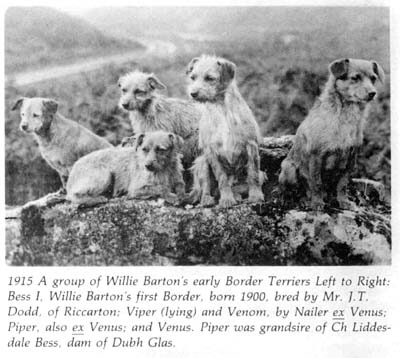
Pictures from Walter Gardner's book About the Border Terrier
The two pictures, above, show what Border Terriers looked like around 1916-1920. I think if these dogs were in the field today most people would not call them Border Terriers -- they would be presented as Fell Terriers.
Though some claim an ancient history for the Border Terrier, no breed of terrier is very old and the Border Terrier is no exception, first appearing around 1860, and being so undifferentiated from other rough-coated terriers that they were not admitted to the UK Kennel Club until 1920 -- after first being rejected in 1914.
The true history of the Border Terrier is exceedingly short and simple despite all the efforts to muddy the water with talk of Walter Scott, Bedlingtons, gypsies, and dark dogs seen in the muddy corners of obscure oil paintings. Such stuff is pure bunk.
The Border Terrier was a kennel type of rough-coated terrier of the Fell type bred by the Robson family. John Robson founded the Border Hunt in Northumberland in 1857 along with John Dodd of Catcleugh who hunted his hounds near the Carter Fell. It was the grandson's of these two gentlemen -- Jacob Robson and John Dodd -- who tried to get the Border Hunt's little terrier-type popularized by the Kennel Club.
The first Kennel Club Border Terrier ever registered was "The Moss Trooper," a dog sired by Jacob Robson's Chip in 1912 and registered in the Kennel Club's "Any Other Variety" listing in 1913. The Border Terrier was rejected for formal Kennel Club recognition in 1914, but won its slot in 1920, with the first standard being written by Jacob Robson and John Dodd. Jasper Dodd was made first President of the Club.
For a terrier "bred to follow the horses" the Border Terrier does not appear to have been overly-popular among the mounted hunts. The Border Terrier Club of Great Britain lists only 190 working certificates for all borders from 1920 to 2004 -- a period of 84 years. Considering that there were over 250 mounted hunts operating in the UK during most of this period (there are about 185 mounted hunts today), this is an astoundingly small number of certificates for a period that can be thought of as being over 15,000 hunt-years long. Even if one concedes that borders were worked outside of the mounted hunts, and not all borders got certificates that were recorded by the Border Terrier Club of Great Britain, the base number is so slow that adding a generous multiplier does not change the broad thrust of the conclusion, which is that Border Terriers never really had a "hay day" for work.
The relative lack of popularity of the Border Terrier as a working terrier is borne out by a careful review of Jocelyn Lucas' book Hunt and Working Terriers (1931). In Appendix I Lucas provides a table listing 119 UK hunts operating in the 1929-1930 season, along with the types of earths found (sandy, rocky, etc.) and the type of terrier used.
Only 16 hunts said they used Borders or Border crosses, while about 80 hunts said they preferred Jack Russells, white terriers or some type of fox terrier. Lakelands and Sealyhams, or crosses thereof, were mentioned by some, with quite a few noting "no preference"(hunts are double-counted if they mention two kinds of terriers or crosses of two types).
The Border Terrier does not appear to be faring any better today, with even fewer workers found in the field than in Lucas' times. In fact, there is not a single Border Terrier breed book that shows a border terrier with its fox -- an astounding thing considering the age of the breed and the ubiquitous nature of the camera from the 1890s forward.
A STAGED PHOTO: William Carruthers poses in a photographers studio with a stuffed otter. The dogs shown are "Allen Piper", "Jean" and "Tally Ho," and the picture was taken sometime after 1923
There is some disagreement as to why the border terrier is not more popular in the working terrier community. Some mention the fact that the dogs are often slow to mature. Others note that the dogs are very expensive, while others note that borders are getting too big. Still others note that the dog is now so rarely worked that it is nearly impossible to get a pup out of two real workers.
To say that the border is not popular in the field does not mean that it has fallen out of favor in the show ring or in the pet trade, however! Border terriers are among the top 10 breeds in the UK Kennel Club, and nearly 1,000 border terriers were registered with the American Kennel Club last year -- up about 100 dogs from the previous year.
.
No comments:
Post a Comment